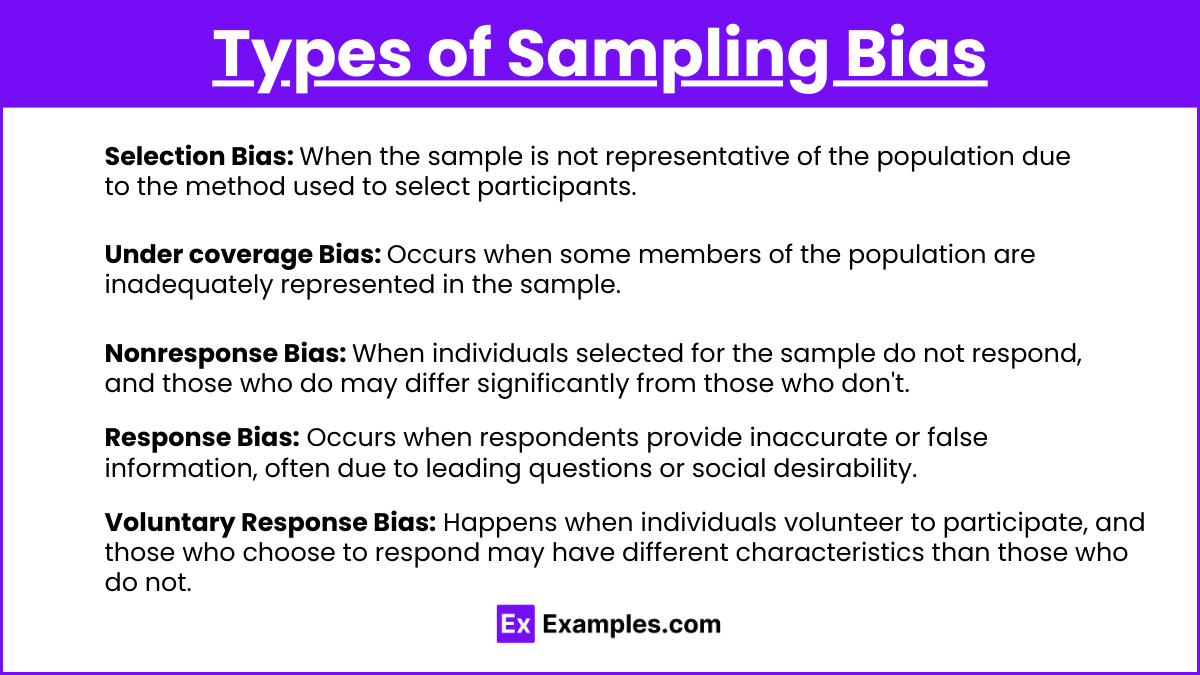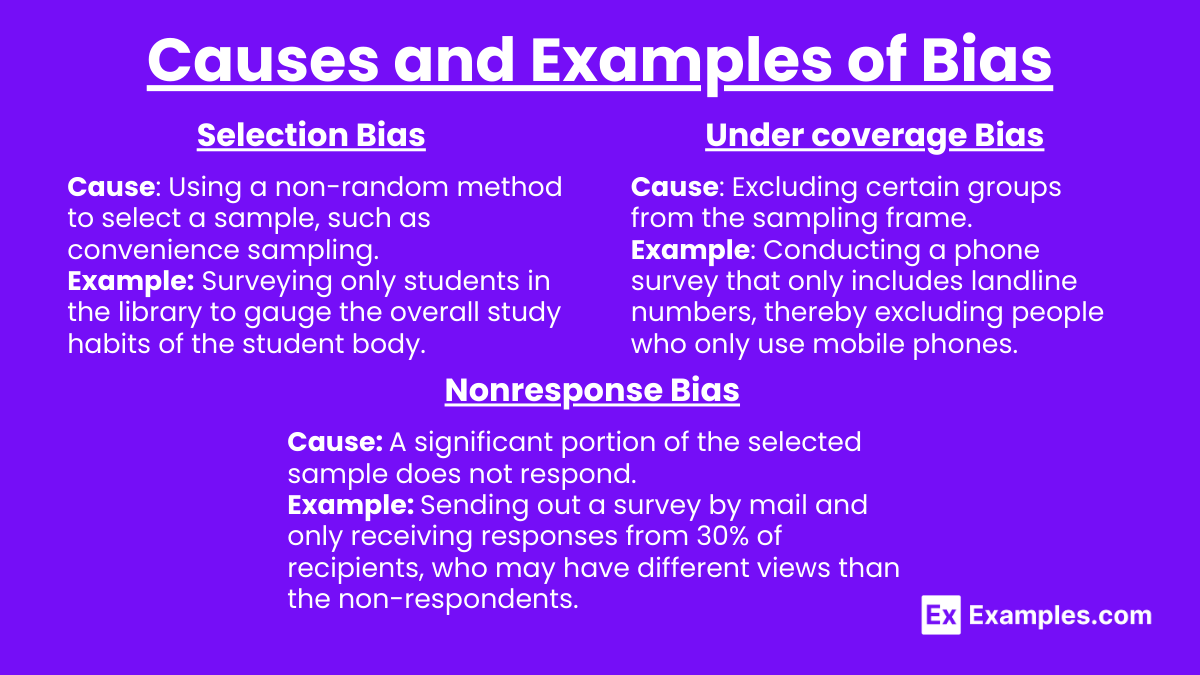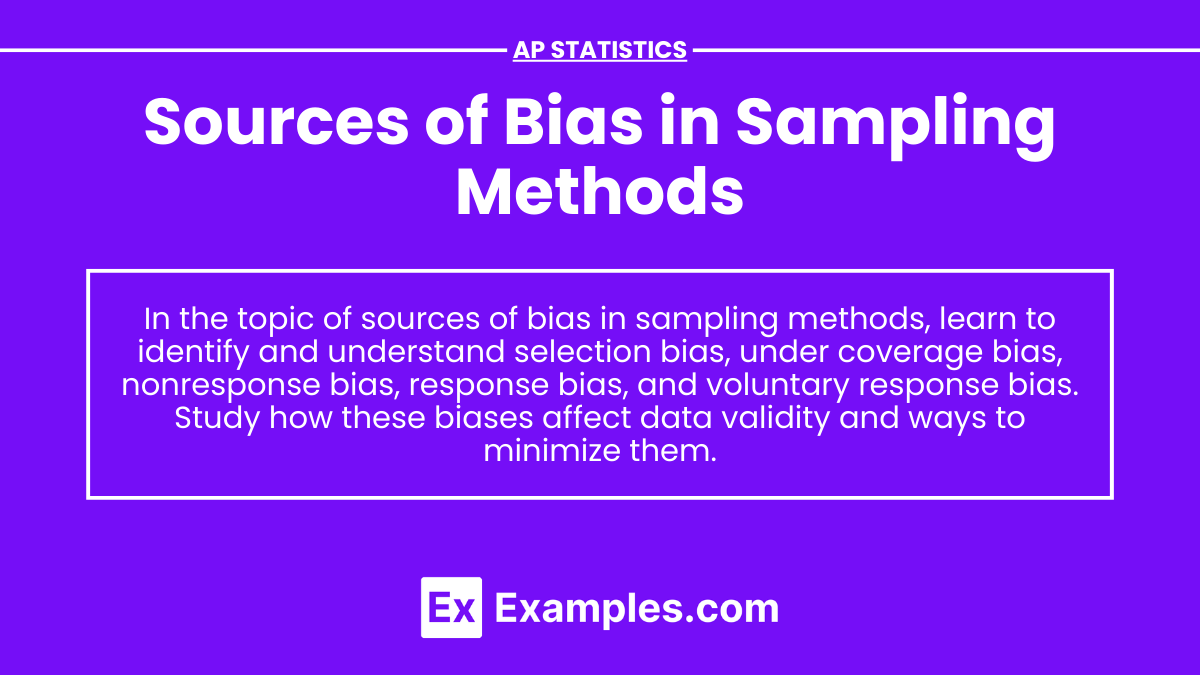In AP Statistics, understanding sources of bias in sampling methods is essential for ensuring accurate and reliable data collection. Bias occurs when certain members of a population are systematically more likely to be selected than others, leading to non-representative samples. Key sources of bias include selection bias, under coverage bias, nonresponse bias, response bias, and voluntary response bias. Recognizing and addressing these biases is crucial for minimizing errors and making valid inferences about the population from the sample.
Learning Objectives
By studying sources of bias in sampling methods, you will learn to identify and mitigate various types of bias such as selection bias, under coverage bias, nonresponse bias, response bias, and voluntary response bias. You will understand how these biases affect the validity of my data and be able to implement techniques to minimize them. This knowledge will enable you to design more accurate and reliable studies, ensuring that my samples are representative of the population.
Definition
Bias in sampling methods occurs when certain members of a population are systematically more likely to be selected in a sample than others, leading to results that are not representative of the population.
Types of Sampling Bias

Selection Bias: When the sample is not representative of the population due to the method used to select participants.
Under coverage Bias: Occurs when some members of the population are inadequately represented in the sample.
Nonresponse Bias: When individuals selected for the sample do not respond, and those who do may differ significantly from those who don't.
Response Bias: Occurs when respondents provide inaccurate or false information, often due to leading questions or social desirability.
Voluntary Response Bias: Happens when individuals volunteer to participate, and those who choose to respond may have different characteristics than those who do not.
Methods to Minimize Bias

Random Sampling: Ensuring every member of the population has an equal chance of being selected.
Stratified Sampling: Dividing the population into strata and randomly sampling from each stratum.
Increasing Response Rates: Using follow-ups and reminders to encourage responses.
Neutral Questioning: Phrasing questions in a neutral manner to avoid leading responses.
Weighting Responses: Adjusting the results to account for underrepresented groups.
Causes and Examples of Bias

Example 1: Selection Bias
Cause: Using a non-random method to select a sample, such as convenience sampling.
Example: Surveying only students in the library to gauge the overall study habits of the student body.
Example 2: Under coverage Bias
Cause: Excluding certain groups from the sampling frame.
Example: Conducting a phone survey that only includes landline numbers, thereby excluding people who only use mobile phones.
Example 3: Nonresponse Bias
Cause: A significant portion of the selected sample does not respond.
Example: Sending out a survey by mail and only receiving responses from 30% of recipients, who may have different views than the non-respondents.
Example 4: Response Bias
Cause: The way questions are phrased or the presence of the interviewer influences responses.
Example: Asking, "Do you agree that the new policy is beneficial?" may lead respondents to feel pressured to agree.
Example 5: Voluntary Response Bias
Cause: Relying on volunteers to participate in the study.
Example: An online poll about customer satisfaction where only very satisfied or very dissatisfied customers are likely to respond.
Multiple Choice Questions
MCQ 1
What is selection bias?
When the sample includes only volunteers.
When some population members are inadequately represented.
When the sample is not representative due to the selection method.
When respondents provide false information.
Answer: 3. When the sample is not representative due to the selection method.
Explanation: Selection bias occurs when the method used to select the sample results in a non-representative sample.
MCQ 2
Which of the following is an example of nonresponse bias?
Surveying only mall shoppers to understand shopping habits.
Sending a survey by email and only receiving responses from 25% of recipients.
Asking leading questions in a survey.
Including only landline numbers in a phone survey.
Answer: 2. Sending a survey by email and only receiving responses from 25% of recipients.
Explanation: Nonresponse bias occurs when a significant portion of the selected sample does not respond, and those who do respond may differ significantly from non-respondents.
MCQ 3
How can response bias be minimized?
Using random sampling techniques.
Ensuring every population member has an equal chance of being selected.
Phrasing questions in a neutral manner.
Increasing the sample size.
Answer: 3. Phrasing questions in a neutral manner.
Explanation: Response bias can be minimized by ensuring questions are phrased in a neutral manner to avoid influencing respondents' answers.


